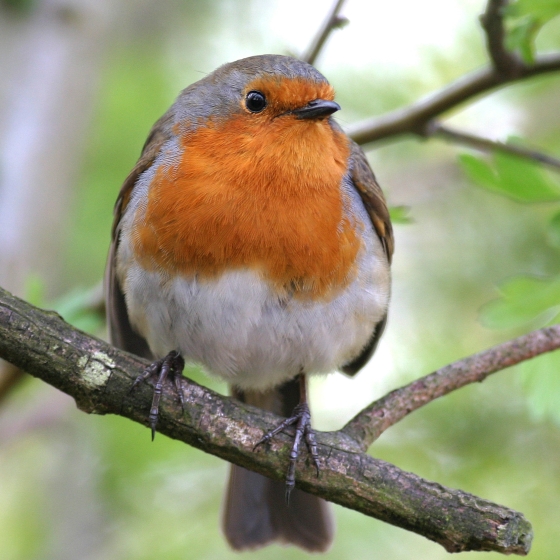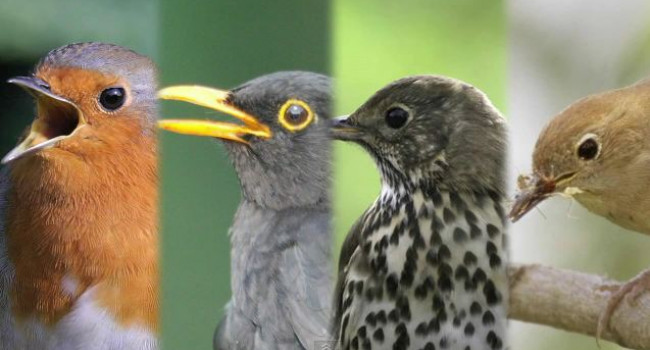Robin
Erithacus rubecula (Linnaeus, 1758)
R.
 ROBIN
ROBIN  10990
10990

Family: Passeriformes > Muscicapidae

The Robin's red breast and habit of living close to humankind makes it one of our most familiar birds.
Robins are widely distributed in Britain & Ireland throughout the year, from Shetland to the Channel Islands, apart from on the highest mountain tops. Robin breeding numbers increased through the last part of the 20th century and have been fairly stable since, albeit with some fluctuations.
The Robin is both a resident and also a migrant visitor to Britain during the winter months, when birds from northern and eastern Europe help to swell numbers. During particularly cold weather this pugnacious little bird can be seen sharing bird tables with several other Robins, all of them trying to defend the food source they have found.
Exploring the trends for Robin
Our Trends Explorer will also give you the latest insight into how the UK's Robin population is changing.
trends explorerIdentification
Robin identification is usually straightforward. The following article may help when identifying Robin.
Identifying Nightingale and other night singers

Contrary to popular opinion, Nightingale is not the only bird that sings at night. In fact, due to its recent decline, you are more likely to hear other birds singing after dark. This video illustrates the difference in song between the four most common 'Night Singers' - Robin, Blackbird, Song Thrush and of course, Nightingale.
SONGS AND CALLS
Listen to example recordings of the main vocalisations of Robin, provided by xeno-canto contributors.
Alarm call
Song
Develop your bird ID skills with our training courses
Our interactive online courses are a great way to develop your bird identification skills, whether you're new to the hobby or a competent birder looking to hone your abilities.
Browse training coursesStatus and Trends
Population size and trends and patterns of distribution based on BTO surveys and atlases with data collected by BTO volunteers.
CONSERVATION STATUS
This species can be found on the following statutory and conservation listings and schedules.
POPULATION CHANGE
Robins have increased markedly since the mid 1980s, according to both CBC/BBS and CES results, having been set back earlier by a succession of cold winters. The CES and BBS data show that marked and significant annual fluctuations occur in numbers, perhaps in response to winter weather, although these are not evident in the smoothed trends: numbers dropped sharply between 2008 and 2012 when three severe winters occurred, but recovered quickly, a further drop occurred following severe weather in February/March 2018 (the 'Beast from the East'). The BBS map of change in relative density between 1994-96 and 2007-09 indicates that increases were strongest over that period in northwestern Britain, while some decrease occurred in Cornwall and south Devon. There has been an increase across Europe since 1980 (PECBMS: PECBMS 2020a>).
| UK breeding population |
+49% increase (1967–2022) 
|
Exploring the trends for Robin
Our Trends Explorer will also give you the latest insight into how the UK's Robin population is changing.
trends explorerDISTRIBUTION
Robins are widespread throughout Britain & Ireland, breeding in 94% of all 10-km squares, and absent only from some of the Scottish islands and from exposed uplands. Densities are highest in Ireland and southern England and lowest in the uplands, especially above 400 m elevation.
Occupied 10-km squares in UK
| No. occupied in breeding season | 2837 |
| % occupied in breeding season | 94 |
| No. occupied in winter | 2903 |
| % occupied in winter | 96 |
European Distribution Map
European Breeding Bird Atlas 2
Breeding Season Habitats
| Most frequent in |
Deciduous Wood 
|
| Also common in | Scrub, Pasture Farmland, Villages, Towns, Coniferous Wood |
Relative frequency by habitat
Relative occurrence in different habitat types during the breeding season.

DISTRIBUTION CHANGE
There has been a 2% range expansion since the 1968–72 Breeding Atlas, with gains in the Outer Hebrides, Caithness and the Northern Isles, probably aided by increased tree planting. Atlas data and other evidence points to an increase in Robin densities in many parts of the UK.
Change in occupied 10-km squares in the UK
| % change in range in breeding season (1968–72 to 2008–11) | +2% |
| % change in range in winter (1981–84 to 2007–11) | +4.7% |
SEASONALITY
Robin is a common and widely recorded species, present on almost 70% of complete lists, though recording dips in late summer after breeding.

Movement
Information about movement and migration based on online bird portals (e.g. BirdTrack), Ringing schemes and tracking studies.
RINGING RECOVERIES
View a summary of recoveries in the Online Ringing Report.
Foreign locations of birds ringed or recovered in Britain & Ireland

Biology
Lifecycle and body size information about Robin, including statistics on nesting, eggs and lifespan based on BTO ringing and nest recording data.
PRODUCTIVITY & NESTING
Exploring the trends for Robin
Our Trends Explorer will also give you the latest insight into how the UK's Robin population is changing.
trends explorerSURVIVAL & LONGEVITY
View number ringed each year in the Online Ringing Report
Maximum Age from Ringing 
|
8 years 4 months 30 days (set in 1977) 
|
Typical Lifespan 
|
2 years with breeding typically at 1 year |
Adult Survival 
|
0.419±0.014  
|
Juvenile Survival 
|
0.41 (in first year) 
|
Exploring the trends for Robin
Our Trends Explorer will also give you the latest insight into how the UK's Robin population is changing.
trends explorerBIOMETRICS
Wing Length 
|
Adults | 73.9±2.1 | Range 70–77mm, N=27010 |
| Juveniles | 73.3±3.9 | Range 70-77mm, N=40553 | |
| Males | 75±1.9 | Range 72–78mm, N=3767 | |
| Females | 72.7±1.8 | Range 70–76mm, N=2745 |
Body Weight 
|
Adults | 19.0±2.2 | Range 15.5–22.8g, N=22245 |
| Juveniles | 17.7±2.5 | Range 14.5–20.9g, N=33913 | |
| Males | 18.5±1.3 | Range 16.6–20.6g, N=3117 | |
| Females | 19.2±2.3 | Range 16.4–23.6g, N=2266 |
Feather measurements and photos on featherbase 
CODES & CLASSIFICATION
Ring size 
|
A |
Field Codes 
|
2-letter: R. | 5-letter code: ROBIN | Euring: 10990 |
For information in another language (where available) click on a linked name
Research
Interpretation and scientific publications about Robin from BTO scientists.
CAUSES AND SOLUTIONS
Causes of change
The causes of change are uncertain as detailed analyses have not been undertaken, but the number of fledglings per breeding attempt increased concurrently with the population increase, whilst survival measures were unchanged, suggesting that increased productivity is the most likely driver.
Further information on causes of change
Improvements have occurred during the period of population increase in the numbers of fledglings per breeding attempt, as measured by nest record data, with a reduction in nest failure rates at the egg stage, although CES productivity measures have been relatively unchanged. The number of fledglings per breeding attempt has decreased more recently which may relate to density-dependent effects. Survival rates, as measured by CES, appear stable. Laying dates have advanced by more than a week since the 1960s.
Information about conservation actions
There are currently no conservation concerns about the Robin, and numbers have increased consistently since the mid-1980s, apart from a brief dip between 2008 and 2012 which was likely to have been caused by severe winter weather. Therefore, no specific conservation actions are currently required to benefit the Robin.
Links to more studies from ConservationEvidence.com
- Potential influence of habitat and predation on local breeding success and population in spotted flycatchers Muscicapa striata
- Repellents to deter New Zealand's North Island robin Petroica australis longipes from pest control baits
- Dynamics and viability of a New Zealand robin population reintroduced to regenerating fragmented habitat
Would you like to search for another species?












Share this page